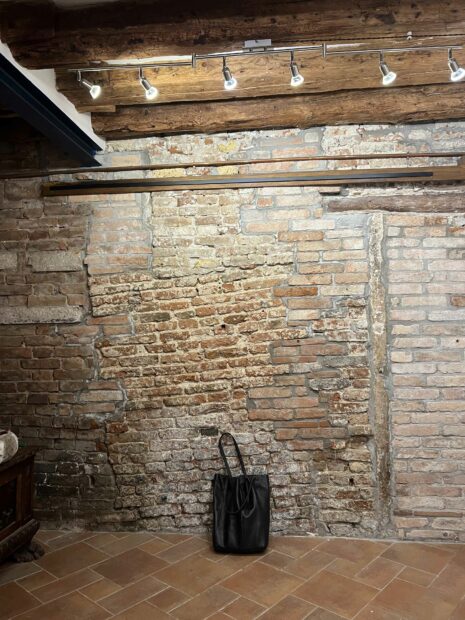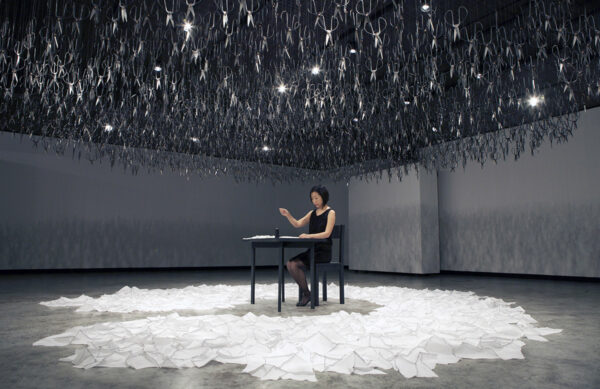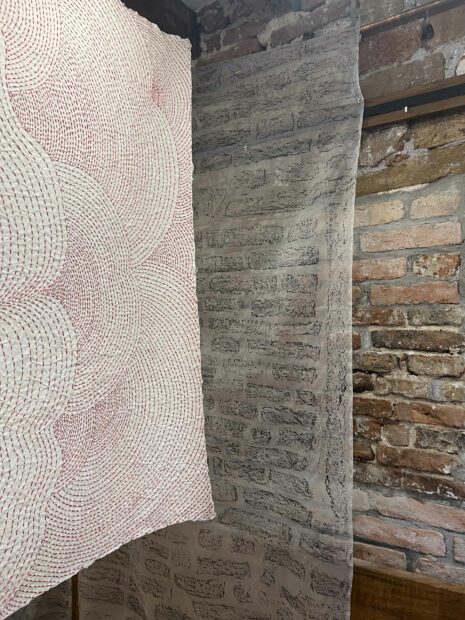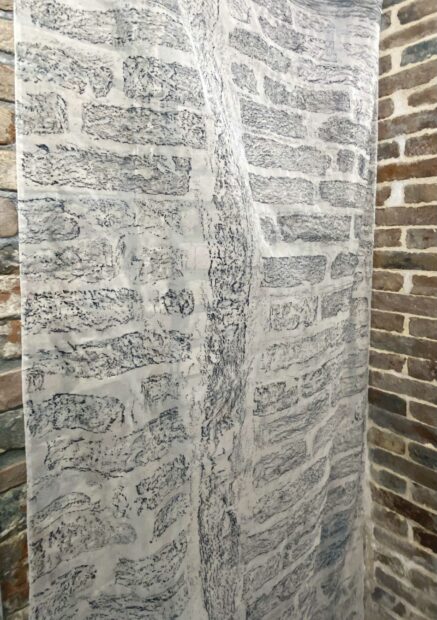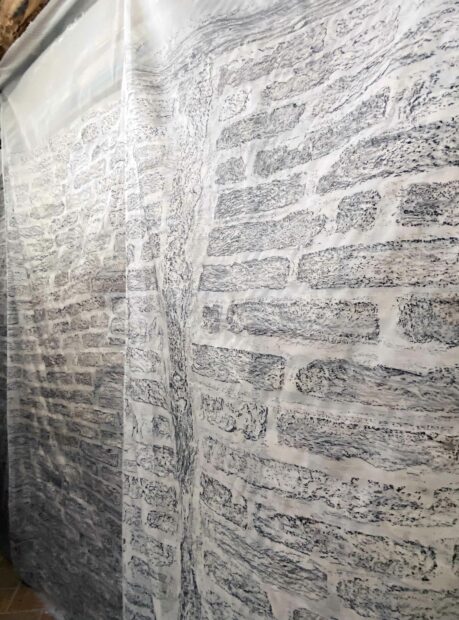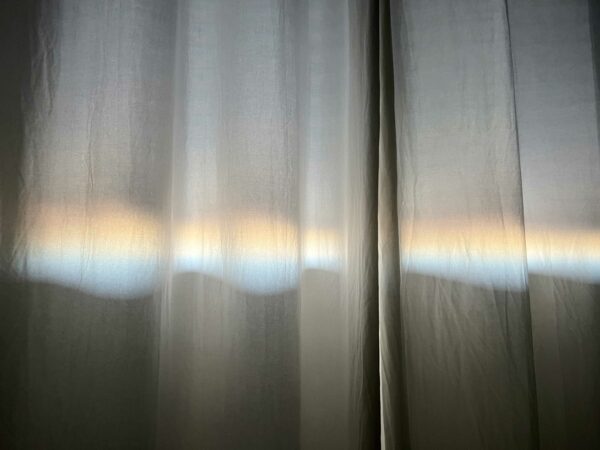This is the fifth and final piece of a multi-part series on Venice, written during the author’s month-long residency and personal hiatus in the city. Read part one here, part two here, part three here, and part four here.
It was dark and stormy the day I ventured to meet Beili Liu at her residency in the Old Jewish Ghetto of Venice’s Cannaregio neighborhood. My blue dot on Google Maps ping-ponged between streets and alleys, almost in response to the wind howling around me. I arrived an hour late, lost, and was relieved when I recognized Beili and her partner, Blue, under a bright red umbrella in the distance coming to rescue me. That morning had proven to be a challenge. The wind and rain made travel across the island complicated. We exchanged the briefest of hugs on the street and I followed the pair around the corner and into the refuge of the studio, where I was almost instantly warmed by the intimacy of the invitation, the space, and the ability to shed my wet coat and wrap my hands around a warm cup of coffee.
It was pure coincidence that we overlapped in Venice. I saw Beili post a process photo of her work on Instagram and immediately reached out. I have followed her work and practice since 2011, after visiting The Mending Project at Women & Their Work in Austin. Visitors were invited to cut pieces of white fabric, which Beili mended back together while sitting under 1,500 pairs of iron scissors suspended from the ceiling. The project stuck with me because of the dichotomies it presented and the delicate way with which Beili herself treated the materials. The piece required a violent action — visitors cutting delicate fabric — and just as delicately, Beili devoted herself to repairing the fabric. Somehow, in all our years living and working in Austin, Beili and I had never met in person. But one can always rely on serendipity, and I had no idea that this 2011 project, coupled with our visit that morning, would serve as a perfect punctuation mark for my time in Venice. It was an endpoint for her, too; the next day, she packed up for her next destination.
The studio was small and cozy. It was situated on the bottom floor of the building and its ceiling was low, with thick, heavy wood beams and ancient brick walls that protected us from the wind and rain howling outside. Beili led me through panels of thin white silk hanging from the ceiling to a table with pastries where we munched, drank our coffee, and took some time to warm up while getting our bearings with one another. Sitting across from her, I noticed that she seems to have a perpetual calmness, a presence that was so soothing that the frenetic energy I carried from the storm and my lateness quickly began to evaporate. She had been in residence at the La Storta exhibition space in collaboration with Venezia Contemporanea, and was making her way to the northern part of the Stockholm Archipelago as an artist-in-residence at BKN Sweden. I can say with certainty that I would not have been as calm or collected on the eve of one residency ending and another beginning, especially if the two required packing up a life and studio.
But Beili is remarkable.
Our conversation turned to time, and more specifically, to her time in Venice and the documentation of it, a subject the city almost pulls from people who are careful enough to pay attention. I documented my time through words, and Beili documented hers through tracing. Indeed, half the studio was filled with the ghostlike works she made every night of the two weeks she was there.
If you really pay attention, it is easy to see how Venice is desperately holding onto itself. Evidence of this desperation in Beili’s studio was laid bare. All of the brick walls had clearly been patched and rebricked multiple times, but on one wall in particular, the horizontal line of bricks leaned dramatically to the left in one section, was visibly repaired with newer, straighter bricks in a paler red color on both sides, and was bisected with a vertical concrete column and a wood cornice. Altogether it was a patchwork of mending, and it illustrated the marks of time on architecture in a sinking city.
Beili mentioned that since The Mending Project, much of her practice has shifted to ideas of mending, and particularly performances and installations that respond to sites and the urgency of the climate crisis. Playing on a laptop in the background was a video of Beili sitting atop a mountain during a snowstorm in Norway, clad in a heavy coat with a fur lined hood, sewing and mending a fabric-based paper with thick red thread. The paper hung behind me, and the water stains, snow patches, wrinkles, and tiniest rips were all visible, bruises on the surface and evidence of a healing process. That same single sheet of paper with red thread floated in front of long and wide sheets of silk hovering in the room, on which Beili made rubbings of the walls using graphite and wax. The result is a document of the studio space itself; a soft, floating, two-dimensional representation of the three-dimensional building we were standing in, including its 500-year-old structural beam. The flaws in the bricks, the patches, crookedness, time — and all the things required to mend it — had been rubbed onto the finest and softest of fabrics.
There is no doubt about the fact that one day Venice will be underwater — much of our planet will — and the rain just outside the studio’s window ensured we didn’t forget that fact. The studio had actually flooded before, and Beili’s next step in the process of her rubbings is to stitch lines across the bottom of the fabric to the levels at which the room flooded in the past. It will be a different kind of mending, one of recognition and reckoning.
Somehow, my visit with Beili during that crazy storm was also a turning point. I had arrived in Venice a small puddle of raw and heartbroken emotion. I experienced the city during the warmth of late summer and early fall, where I could fully blend in because almost everyone is a tourist. I was anonymous in the city, and anonymous in my heartbreak, living in Venice in the sunshine, humidity, and purplish-blue haze of light. The layers of history are obvious, as is the feat of engineering and economy required to build and then sustain a city like Venice. This is evident in every marble brick, every gold-leafed sculpture, and in the sound of water lapping the sidewalk just inches away.
In the weeks I was there I saw more art by women in one place than I ever have. I was part of the team to produce an exhibition with more than 20 artists from Mexico. I saw the great works by the Venetian master painters, including Canaletto, Titian, and Tintoretto. I was able to make sense of how such a small, water-logged place came into some of the greatest power and wealth in Europe while looking up at the gold, mosaic dome in the central nave of St. Mark’s Basilica. I let my heart break a little more standing in front of an installation by Anselm Kiefer that I will never see again. I allowed my heart to be resuscitated, revived, and even mended by spritzes as I sat on a dock in the Grand Canal, on a terrace in Giudecca, by late night pasta, and by a few sunrises in Mestre.
In her temporary studio in a 500-year-old building in the Jewish Ghetto, as the storm raged outside, Beili reminded me of the importance of mending. Perhaps mending will always be my metaphor for Venice: a place for oneself to be pieced together just as much as the city is, both desperately holding onto survival, and surviving nonetheless.
******
Thank you to Beili and Blue for finding me on the street in the rain, for welcoming me into the studio, and for sharing such a special conversation over so much time. Your presence alone had such a profound effect and it will always remain one of my favorite visits. Thank you to Maripili for the trust and the spot-on team. Our show was gorgeous and enormously special, but you also gave us the gift of art history with time and distance away from our day-to-day routine to process it all. Mike, thank you for the opportunity to collaborate together once again, and thank you for the epic runs around the islands, to Lido and back, and the 12-kilometer circles. To the entire team at the Venice Art Factory, including Luca, Elena, and Francsca — thank you for your professionalism. This was the smoothest, easiest, and most delightful project to pull together in a space and place I had never been in before. Some of the best memories are of all the artists that were able to visit and share the experience with us. For those that weren’t able to make it, thank you for trusting us with your work and for making work that is compelling and beautiful. Thank you to Luca for all the spritzes, crossing that bridge far too many times, and for the comprehensive list of every sport that requires a racket.
Thank you to everyone who read these texts. Writing again has been a relief and you have encouraged it. Thank you to Brandon for spending so much time in editing, and to Glasstire for the platform to continue exploring the themes of culture and place which are fundamental to my practice as a writer and curator.
LMC over and out…for now.


